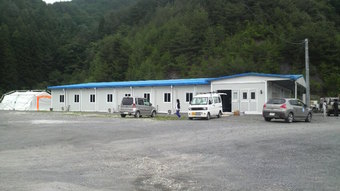
Photo: The temporary clinic of Prefectural Otsuchi hospital (under construction) made of Norwegian products
I have participated in the first, second and now the third month of Doctors of the World’s emotional and psychological care team here in Ohtsuchi.
During the first month, the town was so devastated that it looked like it had suffered from a blanket airstrike and I was pained by witnessing the countless victims being packed tightly into evacuation centers. Local government, care systems, schools – everything had ceased to function. When visiting these evacuation centers, we followed in the wake of the emergency care medical teams, quietly listening to the accounts of those who, besides their physical injuries, had suffered such terrible loss that they found it difficult to even put into words. It was as if the sorrow we were sifting through was so great that it had manifested itself physically in the victims. Medical teams which had been dispatched from all over Japan worked hard together, compiling reports on the situation.
During the second month, the rubble began to be cleared and progress was gradually being made. A makeshift town hall was set up in the school grounds of the local elementary school, a makeshift health clinic was set up inside the precincts of a shrine, schools opened again and the evacuation centers were reorganized. People whose homes had not been totally destroyed but were no longer fit for dwelling spent their days clearing rubble while those who had lost their jobs and homes stayed in the evacuation shelters with the elderly and other vulnerable individuals. Though at first glance the evacuation center may have looked quite calm, the difference in amount of damage suffered among victims became apparent. People who up until then had been restrained began to break down. Pleas for look-term counseling to deal with the very serious and sensitive challenges that people were facing began to come from individuals both in the evacuation centers and those who were fortunate enough to still have their own homes. Meanwhile, the first response medical aid teams were able to withdraw again as their work was complete.
As we entered the third month since the disaster, all the rubble was fully removed and it was now possible to see from town down to the sea again. Temporary, prefab housing sprung up and families that were able to move left the evacuation centers to move in to these new homes. The hospital moved to another makeshift site on the mountainside. Work went ahead to build a new health clinic. The number of medical teams being disbanded increased and health outreach teams took over local care responsibilities.
As the ‘normality’ of the situation impressed itself on the hearts of the victims, everyone from children to the elderly as well as those who had endured immense emotional strain showed signs of instability as they spoke to us with faltering voices. These ranged from those in small, cramped shelters to those in large, anonymous ones, as well as those who were now living in the new makeshift housing. We saw the desperate desire for even just this basic, temporary housing, followed by the worrying sadness which only compounded feelings of isolation and distress once the housing was actually attained. Amid these realities, each of the groups involved with the Tohoku emotional and psychological care team are now withdrawing from this ruined town which suffered a total breakdown of all local care provision, with the aim of returning to previous levels of care provision.
The first resident’s meeting took place recently, which dealt with how things will move forward in Ohtsuchi from now on. So many families still remain officially missing, and each time another body is found calmly pleading victims rush to see if it might be one of their loved ones. Local civil servants in the town hall dutifully attend one by one to local residents while being on the receiving end of so much anger. They work on, even though they themselves are victims of this tragedy and feel a sense of guilt that they survived when so many of their colleagues did not.
Distressed students worry about families on the verge of breaking and use the time they have on their hands while not in the evacuation centers to listen to those who are turning to alcohol to deal with their situation, or the elderly. Their teachers, too, who worry about them, struggle to galvanize themselves under the burden of such loss and grief.
I had at first thought that it was only those who died so tragically and the families who were left behind to grieve for them that were the victims of this disaster. As I went round the shelters, I saw and attended to people one by one, as individuals. But in this close-knit town, all are victims. Not just the dignified, caring individuals, but even the bereaved reach out to support those around them. Those who did not suffer shoulder a sense of guilt toward those who lost everything. Yet while caring for one another as a community, each individual still harbors his or her own worries and fears.
I now feel very dearly about the people of Ohtsuchi and it is my desire to help them in any way I can.
To those people, and to the others who continue to be involved with assisting them, I extend my heartfelt wishes and respect.
PsychiatristãSachihiro Ochi
